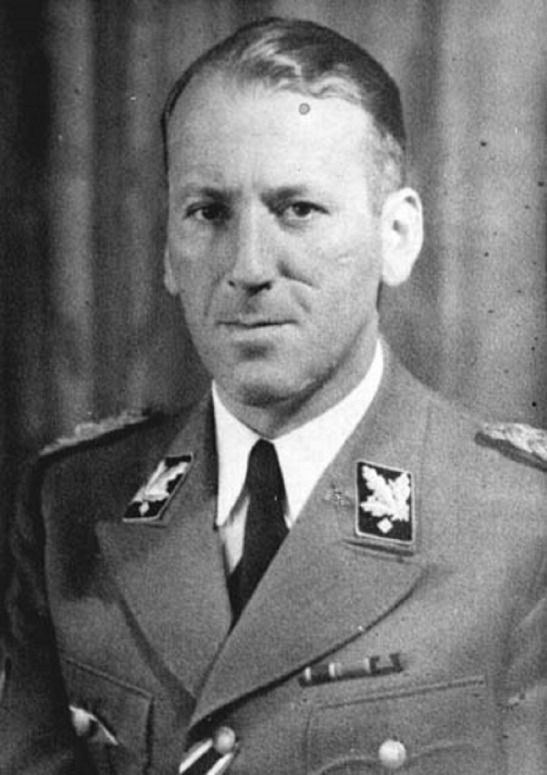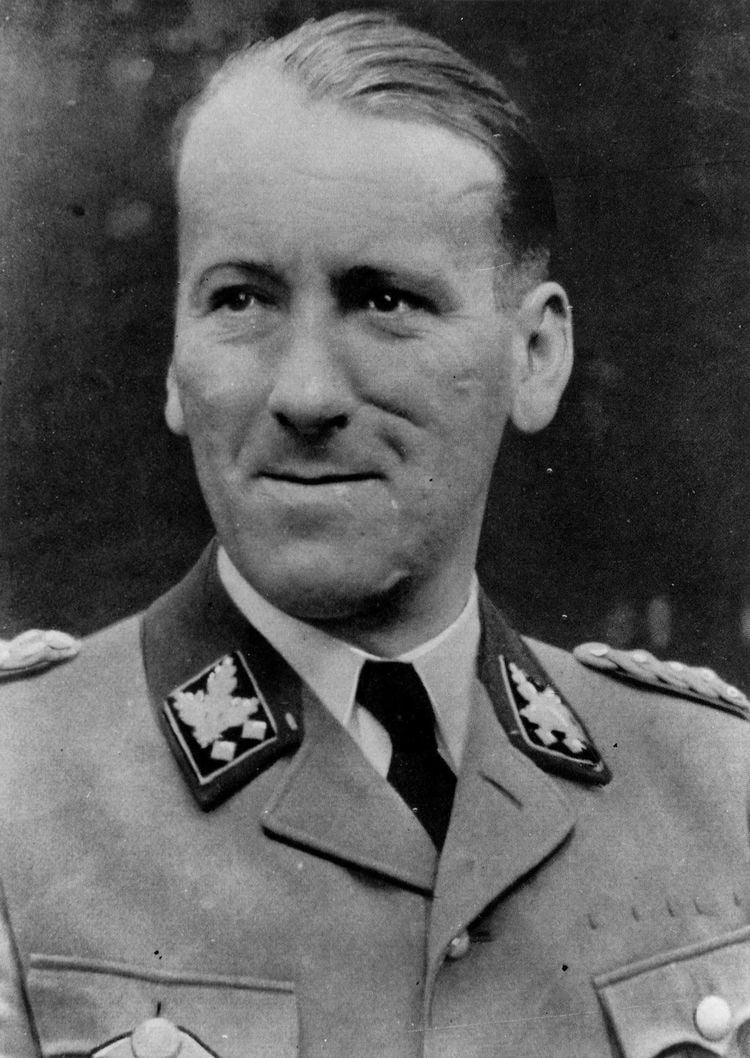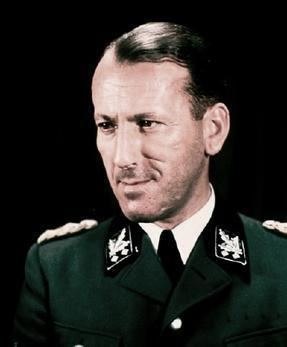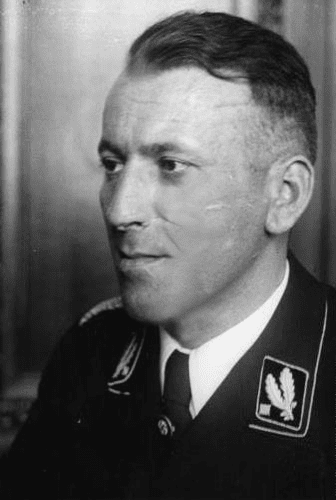Nationality Austrian Succeeded by Florent Louwage Spouse Elisabeth Eder (m. 1934) | Succeeded by None Name Ernst Kaltenbrunner | |
 | ||
Died October 16, 1946, Nuremberg, Germany Children Wolfgang Kaltenbrunner, Ursula Kaltenbrunner, Werner Kaltenbrunner Similar People Fritz Sauckel, Arthur Seyss‑Inquart, Alfred Jodl, Hans Frank, Wilhelm Keitel | ||
Partner Grafin Gisela von Westarp | ||
Ernst kaltenbrunner
Ernst Kaltenbrunner (4 October 1903 – 16 October 1946) was an Austrian-born senior official of Nazi Germany during World War II. An Obergruppenführer (General) in the Schutzstaffel (SS), between January 1943 and May 1945 he held the offices of Chief of the Reich Main Security Office (Reichssicherheitshauptamt; RSHA). He was the highest-ranking member of the SS to face trial at the first Nuremberg trials. He was found guilty of war crimes and crimes against humanity and executed.
Contents
- Ernst kaltenbrunner
- Ernst Kaltenbrunner Wikipedia audio article
- Biography
- SS career
- World War II
- Altaussee Treasures
- Recovered evidence
- Nuremberg trials
- Execution
- In popular culture
- Dates of rank
- References

Ernst Kaltenbrunner | Wikipedia audio article
Biography

Born in Ried im Innkreis, Austria, Kaltenbrunner was the son of a Lawyer, and was educated at the Realgymnasium in Linz. Raised in a nationalist family, Kaltenbrunner was childhood friends with Adolf Eichmann, the infamous SS officer who played a key role in implementing the Nazis' Final Solution against Europe's Jews. After Gymnasium, Kaltenbrunner went on to obtain his doctorate degree in law at Graz University in 1926. He worked at a law firm in Salzburg for a year before opening his own law office in Linz. He had deep scars on his face from dueling in his student days, although some sources attribute them to an automobile accident.

On 14 January 1934, Kaltenbrunner married Elisabeth Eder (b. 1908) who was from Linz and a Nazi Party member. They had three children. In addition to the children from his marriage, Kaltenbrunner had twins, Ursula and Wolfgang, (b. 1945) with his long-time mistress Gisela Gräfin von Westarp (née Wolf). All the children survived the war.
SS career

On 18 October 1930, Kaltenbrunner joined the Nazi Party as NSDAP member number 300,179. In 1931, he was the Bezirksredner (district speaker) for the Nazi Party in Oberösterreich. He went on to join the SS on 31 August 1931, his SS number was 13,039. He first became a Rechtsberater (legal consultant) for the party in 1929 and later held this same position for SS Abschnitt VIII beginning in 1932. That same year, he began working at his father's law practice and by 1933 was head of the National-Socialist Lawyers' League in Linz.
In January 1934, Kaltenbrunner was briefly jailed at the Kaisersteinbruch detention camp with other National Socialists for conspiracy by the Engelbert Dollfuss government. While there he led a hunger strike which forced the government to release 490 of the party members. In 1935, he was jailed again on suspicion of high treason. This charge was dropped, but he was sentenced to six months imprisonment for conspiracy and he lost his license to practice law.
From mid-1935 Kaltenbrunner was head of the illegal SS Abschnitt VIII in Linz and was considered a leader of the Austrian SS. To provide Heinrich Himmler, Reinhard Heydrich and Heinz Jost with new information, Kaltenbrunner repeatedly made trips to Bavaria. Hiding on a train and on a ship that traveled to Passau, he would return with money and Reich orders for Austrian comrades. Kaltenbrunner was arrested again in 1937, by Austrian authorities on charges of being head of the illegal Nazi Party organisation in Oberösterreich. He was released in September.
Acting on orders from Hermann Göring, Kaltenbrunner assisted in the Anschluss with Germany in March 1938, and was thereafter awarded the role as the state secretary for public security in the Seyss-Inquart cabinet. Controlled from behind the scenes by Himmler, Kaltenbrunner still led, albeit clandestinely, the Austrian SS as part of his duty to 'coordinate' and manage the Austrian population. Then on 21 March 1938, he was promoted to SS-Brigadeführer. He was a member of the Reichstag from 10 April 1938 until 8 May 1945. Amid all this activity, he also helped establish the concentration camp at Mauthausen near Linz. On 11 September 1938, Kaltenbrunner was promoted to the rank of SS-Gruppenführer, equivalent to a lieutenant general in the army while holding the position of Führer of SS-Oberabschnitt Österreich (re-designated SS-Oberabschnitt Donau in November 1938). Also in 1938, he was appointed High SS and police leader (Höherer SS- und Polizeiführer; HSSPF) for Donau, which was the primary SS command in Austria (he held that post until 30 January 1943).
World War II
In June 1940, Kaltenbrunner was appointed Police President of Vienna and held that additional post for a year. In July 1940, he was commissioned as a SS-Untersturmführer in the Waffen-SS Reserve. Throughout the course of his many duties, Kaltenbrunner also developed an impressive intelligence network across Austria moving south eastwards, which eventually brought him to Heinrich Himmler's attention for the assignment as chief of the RSHA in January 1943. The RSHA was composed of the SiPo (Sicherheitspolizei: the combined forces of the Gestapo and Kripo) along with the SD (Sicherheitsdienst: Security Service). He replaced Heydrich, who was assassinated in June 1942. Kaltenbrunner held this position until the end of the war. Hardly anyone knew the chain-smoking Kaltenbrunner and upon his appointment, Himmler transferred responsibility for both SS personnel and economics from the RSHA to the SS Main Economic and Administrative Office. Nonetheless, he was promoted to SS-Obergruppenführer und General der Polizei on 21 June 1943. He also replaced Heydrich as President of the International Criminal Police Commission (ICPC), the organization today known as Interpol.
Fear of a collapsing home-front due to the Allied bombing campaigns and that another "stab-in-the-back" at home could arise as a result, caused Kaltenbrunner to immediately tighten the Nazi grip within Germany. From what historian Anthony Read relates, Kaltenbrunner's appointment as RSHA chief came as a surprise given the other possible candidates like head of the Gestapo, Heinrich Müller, or even SD foreign intelligence chief, Walter Schellenberg. Historian Richard Grunberger also added the name of Dr. Wilhelm Stuckart, the future minister of the German Interior as another potential candidate for head of the RSHA; however, he suggests that Kaltenbrunner was most likely selected since he was a comparative "newcomer" who would be more "pliable" in Himmler's hands.
Like many of the ideological fanatics in the regime, Kaltenbrunner was a committed anti-Semite. According to former SS-Sturmbannführer Hans Georg Mayer, Kaltenbrunner was present at a December 1940 meeting between Hitler, Goebbels, Himmler, and Heydrich, where it was decided to gas all Jews incapable of heavy physical work. Under Kaltenbrunner's command, the persecution of Jews picked up pace as "the process of extermination was to be expedited and the concentration of the Jews in the Reich itself and the occupied countries were to be liquidated as soon as possible." Kaltenbrunner stayed constantly informed over the status of concentration camp activities, receiving periodic reports at his office in the RSHA.
During the summer of 1943, Kaltenbrunner made his second inspection of the Mauthausen-Gusen concentration camp. While there, 15 prisoners were selected to demonstrate for Kaltenbrunner three methods of killing; by gunshot to the neck, hanging and gassing. After the killings were performed, Kaltenbrunner inspected the crematorium and later the quarry. In October 1943, he ordered Herbert Kappler, the head of German police and security services in Rome, that the "eradication of the Jews in Italy" was of "special interest" and [for] "general security". Four days later, Kappler's SS and police units began rounding up and deporting Jews by train to Auschwitz concentration camp.
In 1944 when Hitler was in the process of strong-arming Admiral Horthy into submitting Hungary to the Nazis during an arranged meeting in Klessheim Castle in Salzburg, Kaltenbrunner was present for the negotiations and escorted him out once they were over. Accompanying Horthy and Kaltenbrunner on the journey back to Hungary was Adolf Eichmann who brought with him a special Einsatzkommando unit to begin the process of "rounding up and deporting Hungary's 750,000 Jews."
It was often said that even Himmler feared him, as Kaltenbrunner was an intimidating figure with his 1.94 metres (6 ft 4 in) height, facial scars and volatile temper. Kaltenbrunner was also long-time friends with Otto Skorzeny and recommended him for many secret missions, allowing Skorzeny to become one of Hitler's valued agents. Kaltenbrunner was also responsible for heading Operation Long Jump, the attempt to assassinate Stalin, Churchill, and Roosevelt. This mission was thwarted by Soviet intelligence agent Gevork Vartanian.
Immediately in the wake of the 20 July Plot on Hitler's life, Kaltenbrunner was summoned from RSHA headquarters in Berlin to the Wolfsschanze by Himmler to begin the investigation into who was responsible for the attack. Once it was revealed that a military coup against Hitler had occurred, Himmler and Kaltenbrunner had to tread carefully as the military was not under the jurisdiction of the Gestapo or the SD. Since Hitler survived and the conspirators were somewhat inept, they were quickly exposed. Before Kaltenbrunner had finished the summary arrests for any and all persons connected with the attempted coup, there were upwards of 5,000 executions with many more thousands sent off to concentration camps. Interrogation reports were regularly sent by Kaltenbrunner to Martin Bormann (who remained constantly at Hitler's side). The police work on this case continued until the very end of the war with notorious Nazi judge Roland Friesler presiding over the cases; many of those first military officers convicted were agonizingly killed via hanging by piano wire which was suspended from butcher's hooks. As head of the RSHA, Kaltenbrunner also saw to it that many members of the conspirators' families were also murdered.
Historian Heinz Höhne counted Kaltenbrunner among fanatic Hitler loyalists and described him as being committed "to-the-bitter-end." Field reports from the SD in October 1944 about the deteriorating morale in the military and the related court-martial cases (which for committed Nazis like Kaltenrbunner indicated a lack of National Socialist commitment), caused him to seek the involvement of the RSHA into military court-martial proceedings; this was rejected by Himmler who thought it "unwise" at the time to interfere in Wehrmacht affairs. In December 1944, Kaltenbrunner was granted the rank of General of the Waffen-SS. Other SS General Officers were granted equivalent Waffen-SS ranks in 1944 as well, so that in the event of being captured by the Allies, they would have status as military officers instead of police officials. For those who had held police rank prior to 1944, the SS General's title could become rather lengthy. Kaltenbrunner was listed on the SS rolls in 1945 as SS-Obergruppenführer und General der Polizei und Waffen-SS. On 15 November 1944 he was awarded the Knights Cross of the War Merit Cross with Swords. In addition, he was awarded the NSDAP Golden Party Badge and the Blutorden (Blood Order).
Using his authority as Chief of the RSHA, Kaltenbrunner issued a decree on 6 February 1945, that allowed policemen to shoot people solely at their discretion and without judicial review. During mid-February 1945, as things began to quickly deteriorate for the Germans, following the Allied bombing campaigns and the Eastern approach of the Red Army, Hitler was challenged by General Heinz Guderian to begin a major counter-offensive. While Hitler felt that Himmler could capably lead this effort, Guderian disagreed and insisted that Lieutenant-General Walther Wenck spearhead the campaign. Among those present were several at the top of the Nazi hierarchy, Kaltenbrunner included. After many hours of bickering, Hitler finally consented. While the initial counter-attack was successful, the Waffen-SS forces and German Twelfth Army under Wenck were sent reeling two days later on 21 February 1945 by Zhukov's Soviet Red Army forces. Despite not having personally led the attack, this failure by the Waffen-SS was a major blow to Himmler's standing with Hitler and from this time forward, Kaltenbrunner enjoyed a greater degree of autonomy, reporting directly to the Führer and even forming a close bond with Bormann.
On 12 March 1945, a meeting took place in the Vorarlberg between Kaltenbrunner and Carl Jacob Burckhardt, president of the International Committee of the Red Cross (1945–48). By this stage the Nazis were willing to make some concessions to the wishes of the Red Cross. Just over a month later, Himmler was informed that SS-Obergruppenführer Karl Wolff had been negotiating with the Allies for the capitulation of Italy. When questioned by Himmler about the matter, Wolff explained that he was operating under Hitler's orders in negotiating prisoner exchanges and was attempting to play the Allies against one another; Himmler believed him. Kaltenbrunner did not and asked to speak privately with Himmler whereupon he revealed that an informant claimed Wolff also negotiated with Cardinal Schuster of Milan and was about to surrender all of Italy and with it, the German southern front to the Allies. Himmler angrily repeated the allegations and Wolff, feigning offense, boldly challenged Himmler to present these statements to Hitler in his presence. Unnerved by Wolff's demands, Himmler backed down and instead sent Kaltenbrunner and Wolff to the Führerbunker. The warm reception by Hitler and Wolff's open discussion concerning the fruitful negotiations with Allen Dulles must have silenced Kaltenbrunner, as Hitler sent Wolff back to Italy to seek better terms with the Americans.
On 18 April 1945, Himmler named Kaltenbrunner Commander-in-Chief of those remaining German forces in Southern Europe. Kaltenbrunner reorganized his intelligence agencies as a stay-behind underground network. He divided the subcommands between Otto Skorzeny, head of the sabotage units, and Wilhelm Waneck, who kept in contact not only with Kaltenbrunner and other centers in Germany, but also with stay-behind agents in the southern European capitals. Hitler made one of his last appearances on 20 April 1945 outside the bunker, where he pinned medals on boys from the Hitler Youth for their bravery, an event which was partly captured on film. Present at the ceremony were Goering, Speer, Goebbels, Himmler, Dönitz, Keitel, Kaltenbrunner and a few others. Realizing the end of the Nazi regime was near, most of them eagerly parted ways. Kaltenbrunner was among those who fled.
Altaussee Treasures
In late April 1945, Kaltenbrunner fled his Berlin headquarters and made his way to Altaussee, where he had often vacationed and had strong ties. While there, he opposed and thwarted the efforts of local governor August Eigruber to destroy the huge and irreplaceable collection of art stolen by the Nazis from museums and private collections across occupied Europe (more than 6,500 paintings plus statuary) which had been intended for Hitler's planned Führermuseum in Linz.
Ernst Kaltenbrunner's nephew, Michl Kaltenbrunner, said that the Nazis had buried a treasure in Lake Toplitz. It was also the first time any related family member of Ernst Kaltenbrunner gave information in regards to their relative and the dumping of valuables by the Nazi. Ernst Kaltenbrunner also allegedly acted in defiance of Hitler's orders in helping to save the artworks stored in the Altaussee salt mines near Lake Toplitz from being destroyed. Kaltenbrunner's nephew substantiated claims made by Austrian journalist Konrad Kramar in his book Mission Michelangelo that Ernst Kaltenbrunner allowed Austrian miners in charge of the area to remove the explosives that were planted to blow the mines up.
Eigruber was determined to carry out what he had determined was Hitler's desire – to prevent the artworks from falling into the hands of "Bolsheviks and Jews" by destroying everything with explosives. Working with Dr. Emmerin Pöchmüller, the mine overseer, Kaltenbrunner countermanded the order and had the explosives removed. Thus, such world treasures as Michelangelo's Madonna of Bruges stolen from the Church of Our Lady in Bruges, and Jan van Eyck's Ghent Altarpiece, stolen from Saint Bavo Cathedral in Ghent, as well as Vermeer's The Astronomer and The Art of Painting were not destroyed.
This claim by Kaltenbrunner's relative is not depicted in George Clooney's The Monuments Men, in which Kaltenbrunner's character does not appear.
Recovered evidence
In 2001, Ernst Kaltenbrunner's personal Nazi security seal was found in an Alpine lake in Styria, Austria, 56 years after he had thrown it away in an effort to hide his identity. The seal was recovered by a Dutch citizen on vacation. The seal has the words "Chef der Sicherheitspolizei und des SD" (Chief of the Security Police and SD) engraved on it. Experts have examined the seal and believe it was discarded in the final days of the war in May 1945. It was one of Kaltenbrunner's last acts as a free man. On 12 May 1945, Kaltenbrunner gave himself up, claiming to be a doctor and offering a false name. However, his mistress chanced to spot him as he was led away, called out his name and rushed to hug him. This action tipped off the Allied troops, resulting in his trial and execution. However, according to other sources, Kaltenbrunner's true identity was not discovered by chance. A first-hand account of the arrest from CIA documents clearly states that the American soldiers who arrested Kaltenbrunner were actively searching for him. The Americans were highly confident they had the right man when Kaltenbrunner was arrested, even before his mistress removed any lingering doubt.
Nuremberg trials
At the Nuremberg trials, Kaltenbrunner was charged with conspiracy to commit crimes against peace, war-crimes and crimes against humanity. Due to the areas over which he exercised responsibility as a ranking SS general and as chief of the RSHA, he was acquitted of "crimes against peace" but held responsible for "war crimes" and "crimes against humanity".
During the initial stages of the Nuremberg trials, Kaltenbrunner was absent because of two episodes of subarachnoid hemorrhage, which required several weeks of recovery time. After his health improved, the tribunal denied his request for pardon. When he was released from a military hospital he pleaded not guilty to the charges of the indictment against him. Kaltenbrunner stressed during cross-examination that all decrees and legal documents which bore his signature were "rubber-stamped" and filed by his adjutant(s). Hours were spent in "futile pursuit" to get him to admit that thousands of documents bore his signature; he remained resolute on this matter and even went on to blame Heinrich Müller for illegally fixing his signature on the numerous documents in question.
Several among the accused, particularly members of the military leadership, found the presence of both Julius Streicher and Kaltenbrunner unsavory and ill-suited for their company. During the trial, Kaltenbrunner argued in his defense that his position as RSHA chief existed only in title and was only committed to matters of espionage and intelligence. He maintained that Himmler, as his superior, was the person actually culpable for the atrocities committed during his tenure as chief of the RSHA. Kaltenbrunner also asserted that he had no knowledge of the Final Solution before 1943 and went on to claim that he protested against the ill-treatment of the Jews to Himmler and Hitler. Further denials from Kaltenbrunner included statements that he knew nothing of the Commissar Order and that he never visited Mauthausen concentration camp, despite witness reports from camp guards who testified otherwise. Throughout the examinations on stand, Kaltenbrunner was argumentative and confused the court with his circuitous responses. At one point during the trial, he went so far as to avow that he was responsible for bringing the Final Solution to an end.
The International Military Tribunal determined that Kaltenbrunner was a functionary in matters involving the sphere of the RSHA's intelligence network, but the evidence also showed that he was an active authority and participant in many instances of war crimes and crimes against humanity. On 30 September 1946, the IMT found Kaltenbrunner not guilty of crimes against peace. However, he was found guilty of war crimes and crimes against humanity (counts three and four). On 1 October 1946, the IMT sentenced him to death by hanging.
Execution
Kaltenbrunner's last words were:
I have loved my German people and my Fatherland with a warm heart. I have done my duty by the laws of my people and I am sorry that in this hardest of time my people were led by men who were not soldiers and that crimes were committed of which I had no knowledge. Germany, good luck.
Kaltenbrunner was executed by hanging on 16 October 1946, around 1:15 a.m., in Nuremberg. His body, as those of the other nine executed men and that of Hermann Göring (who had committed suicide the previous day), was cremated at the Eastern Cemetery in Munich and the ashes were scattered in a tributary of the River Isar.
In popular culture
Kaltenbrunner has been portrayed by the following actors in film, television and theater productions, including:
The character Ernie Kaltenbrunner from the 1985 zombie film The Return of the Living Dead was named after Ernst Kaltenbrunner.
